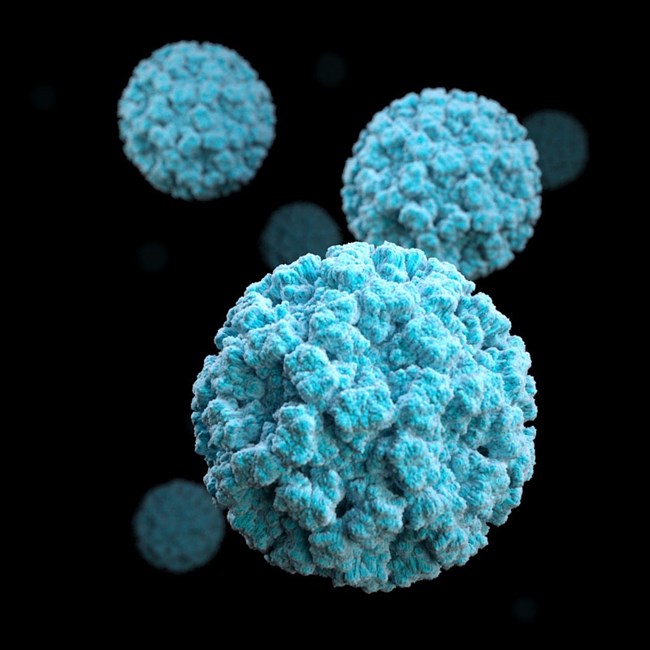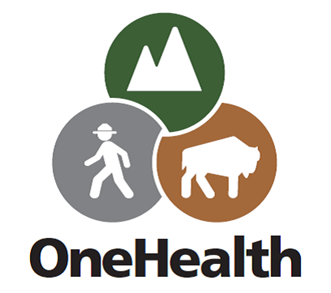Last updated: September 6, 2024
Article
Norovirus
(This page is part of a series. For information on other illnesses that can affect NPS employees, volunteers, commercial use providers, and visitors, please see the NPS A–Z Health Topics index.)

Image/CDC
Humans: Norovirus is a very contagious virus that can affect anyone, causing acute gastroenteritis that some people have called the "stomach flu" (although norovirus is not related to the influenza/flu virus). Genogroups GI, GII, and GIV cause human disease. Symptoms usually develop 12–48 hours after being exposed to infectious droplets and include nausea, vomiting, and watery diarrhea with abdominal cramps. Some people may have low-grade fever, headaches, and body aches. Symptoms usually last from 24–72 hours, and most people recover completely. However, some people can get dehydrated, especially young children, the elderly, and people with underlying illnesses. Norovirus can be found in your stool (feces) even before you start feeling sick and stay in your stool for two weeks after you feel better. However, you are most contagious when you are sick and during the first few days after you recover. Norovirus is found in the stool or vomit of infected people, and people with norovirus illness can shed billions of virus particles that spray through the air and land on people or surfaces. People can become infected with the virus in several ways, including when they:
- Have close personal contact with an infected person.
- Consume food or drinks that are contaminated with norovirus.
- Touch surfaces, objects, or substances contaminated with norovirus and then touch their mouth
- Swallow aerosolized vomit.
Animals: Although human norovirus has been identified in wild birds and rodents, animals are not known to be a main reservoir or cause of transmission, and evidence of transmission from animals to humans is sparse. However, oysters and other filter-feeding shellfish can contain norovirus that infects humans, and multiple human outbreaks have been linked to eating shellfish species.
Environment: Norovirus can be infectious at a very lose dose (it takes fewer than 20 norovirus particles to make a person sick) and can easily contaminate environmental surfaces (including furniture, railings, doorknobs, carpeting, etc.), drinking water, recreational water, and soil/sand. Norovirus can persist on surfaces for days or weeks and in water for several months or possibly even years. It is hardy and can survive freezing as well as temperatures as high as 145°F. Norovirus is resistant to many common disinfectants; the CDC recommends using chlorine bleach or U.S. Environmental Protection Agency (EPA)-approved disinfectant.Chlorine-based disinfection, which is effective against norovirus, can be toxic to human health, wildlife, and the environment and should be used with this consideration in mind.Travel groups in back-country settings may be at increased risk for norovirus due to close contact and limited hand washing capabilities.
PREVENTION
- Wash your hands carefully with soap and water, especially after using the toilet, changing a diaper, and before eating, preparing, or handling food. Alcohol-based hand sanitizers may be used in addition to hand washing, but they should not be used as a substitute for washing with soap and water, as they are less effective against norovirus.
- In the backcountry, boil your water or use a chemical disinfectant; most filters are not sufficient to remove this virus. See additional NPS information on purifying water or CDC information on water treatment while hiking, camping, and traveling.
- If preparing foods, wash fruits and vegetables well and cook seafood thoroughly.
- Clean and disinfect surfaces, counters, and utensils regularly.
- If you become sick and suspect norovirus: Stay away from others. Norovirus spreads easily from person to person.
- Avoid sharing personal items, food, or drink with others.
- Drink plenty of liquids to replace fluid loss and prevent dehydration. Antibiotics will not help with norovirus, because antibiotics are not effective against viruses. Contact your healthcare provider for additional advice. Also, please report any confirmed illnesses to the NPs Office of Public Health (publichealthprogram@nps.gov) as directed in the “Disease Reporting” guidance below.
- Flush or discard any vomit and/or stool in the toilet and make sure the surrounding area is kept clean.
- Immediately remove and wash clothing or linens that may be contaminated with virus after an episode of illness, wash with hot water and detergent, and dry them at the highest temperature as soon as possible.
- For employees: If there is concern of transmission (3+ cases with similar symptoms):
- Contact the Office of Public Health and/or your local/state health department.
- Notify others and provide information (see fact sheets below in “Resources” section below).
- Encourage and provide supplies for handwashing. Remember that handwashing with soap and water is more effective than alcohol-based sanitizers.
- Ensure safe food handling procedures are followed for food preparation and food service.
- Ensure sick employees stay home. Food service workers and school/daycare workers should stay home when sick and for at least 48 hours after they no longer have symptoms.
- Enhance routine cleaning and clean and disinfect thoroughly any areas where people have been sick. Use a chlorine bleach solution with a concentration of 1,000 to 5,000 ppm (5 to 25 tablespoons of 5% household bleach or 3 to 16 tablespoons [8%] bleach per gallon of water) or another disinfectant registered as effective against norovirus by the Environmental Protection Agency (See “EPA’s List G: EPA’s Registered Antimicrobial Products Effective Against Norovirus”). (For more information, see "NPS Norovirus Response-Cleanup" in the NPS Resources section).
- With outbreaks on backcountry rafting trips, refer to the “Norovirus on the River” document for specific prevention and response recommendations, including testing.
| Recommended Bleach Solutions to Inactivate Norovirus | ||
| % Bleach | Amount of Bleach to Add to 1 Gallon of Water to Achieve 1,000 ppm (mg/L) Solution (Tablespoons) | Amount of Bleach to Add to 1 Gallon of Water to Achieve 5,000 ppm (mg/L) Solution (Tablespoons) |
| 5.25 | 4.9 | 24.4 |
| 8.25 | 3.1 | 15.5 |
| 12.5 | 2.0 | 10.2 |
Last updated: 4/13/2023

NPS
- NPS Norovirus Fact Sheet (internal)
- NPS Norovirus Response-Cleanup Fact Sheet (internal)
- NPS Norovirus Response and Cleanup (web)
- NPS poster to help prevent the spread of norovirus in the backcountry (available upon request from publichealthprogram@nps.gov)
- Norovirus on the River: Protect your guests, coworkers, and yourself
- CDC Norovirus webpage
- CDC Norovirus General Fact Sheet
- CDC Fact Sheet, “Water treatment while hiking, camping, and traveling”
- CDC Facts for Food Workers
- CDC Norovirus Prevention at Youth Camps
- EPA's List G: Registered Antimicrobial Products Effective Against Norovirus
- Boulware DR. Influence of hygiene on gastrointestinal illness among wilderness backpackers. J Travel Med. 2004;11(1):27-33. doi:10.2310/7060.2004.13621
- Dale AP, Miko S, Calderwood LE, et al. Outbreak of Acute Gastroenteritis Among Rafters and Backpackers in the Backcountry of Grand Canyon National Park, April-June 2022. MMWR Morb Mortal Wkly Rep. 2022;71(38):1207-1211. doi:10.15585/mmwr.mm7138a2
- Jones EL, Gaither M, Kramer A, Gerba CP. An analysis of water quality in the Colorado River, 2003-04; an investigation into recurring outbreaks of norovirus among rafters. Wilderness Environ Med. 2009;20(1):6-13. doi:10.1580/06-WEME-OR-43.1
- Kitajima M, Iker BC, Magill-Collins A, Gaither M, Stoehr JD, Gerba CP. Genetic Analysis of Norovirus Strains that Caused Gastroenteritis Outbreaks Among River Rafters in the Grand Canyon, Arizona. Food Environ Virol. 2017;9(2):238-240. doi:10.1007/s12560-017-9282-8
- Magill-Collins A, Gaither M, Gerba CP, Kitajima M, Iker BC, Stoehr JD. Norovirus Outbreaks Among Colorado River Rafters in the Grand Canyon, Summer 2012. Wilderness Environ Med. 2015;26(3):312-318. doi:10.1016/j.wem.2015.02.007
- Malek M, Barzilay E, Kramer A, et al. Outbreak of norovirus infection among river rafters associated with packaged delicatessen meat, Grand Canyon, 2005. Clin Infect Dis. 2009;48(1):31-37. doi:10.1086/594118
- Peipins LA, Highfill KA, Barrett E, et al. A Norwalk-like virus outbreak on the Appalachian Trail. J Environ Health. 2002;64(9):18-23, 32.
